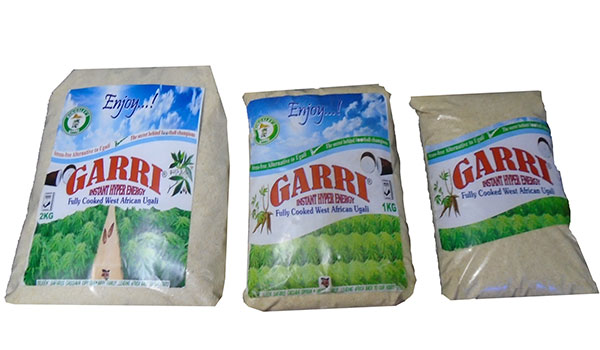Introducing Garri
Garri as it is popularly known in West/Central Africa and Brazil, is the most valued cassava food product and the principal staple food of most West/Central African countries, it constitutes a daily meal for over 350 million people in that region and is the staple meal of over 800million people across the world. Garri can be prepared in many ways and the end result can be a whole meal, a snack or breakfast cereal.
In addition, cassava processed in the form of tapioca enjoys a sizeable export market in Asia, Europe and America. Its relative ease of production, very high yield and ability to stay long in the ground after maturity gives cassava a distinct advantage as a cash crop. Similarly, more than 100 different products are produced from cassava for Human consumption, industrial use as well as livestock/pet feeds. Garri is a nutritious and healthy product, it is more fibrous and less starchy, it naturally contains vitamin B, C and additional nutrients from palm oil used in its preparation.

A Product that is Easy to use and Prepare
The staple food for most of East Africans is Ugali (Sima), also known as mealy meal in Southern Africa. It is usually made from white maize and is cooked in much the same way as Italian polenta which is made from yellow maize. Both polenta and ugali have the same properties and they both need cooking. While Garri has the same look as Ugali and is consumed in a similar manner, it also differs in many important ways.
- Garri is a Gluten and cyanide free product.
- Garri does not require any cooking in its preparation as a full meal or cereal.
- Garri is a pre-cooked product with simple instructions: JUST ADD WATER (the water can be either Hot or Cold)
- Garri triples in mass when mixed three-part liquid to one part product
- Garri is light, easy to use and is suitable for areas with few cooking facilities.
- Garri can be mixed with all spicy foods.
- Garri can be mixed with cold milk, sugar, or honey into a sweet cereal (ideal food for the sick, the elderly and young children).
- Garri has a longer shelf life of more than two years (the nutritional value of the product is not lost with storage).
- Garri does not lose any cooked portion to the pot unlike ugali which losses more than 5% after cooking.
- Garri can easily be warmed in a microwave just like any other cooked meal.
- Garri does not leave a messy pot after cooking
- Unlike maize flour, Garri does not have a second-grade product.
- Garri does not disintegrate when it gets cold.
Benefits of Garri
The most tangible benefits for consumers of Garri is better nutrition which leads to better health. The health benefits are well documented and include:
- A natural source of vitamin B and C (48.2mg/100g)
- A natural source of magnesium, potassium, iron and calcium.
- Vitamins A and E contained in palm oil which is used in its preparing.
- Easy to digest yet rich in soluble fibres, it is easier on the stomach and is often recommended for patients recovering from illness or surgery and for people who suffer from acid indigestion or other digestive disorders.
- It has also been found to be helpful in cases of celiac and liver disease.
Unveiling the power of cassava, Unlock your cassava potential with Cassava Option Consultants & Marketing Limited.

